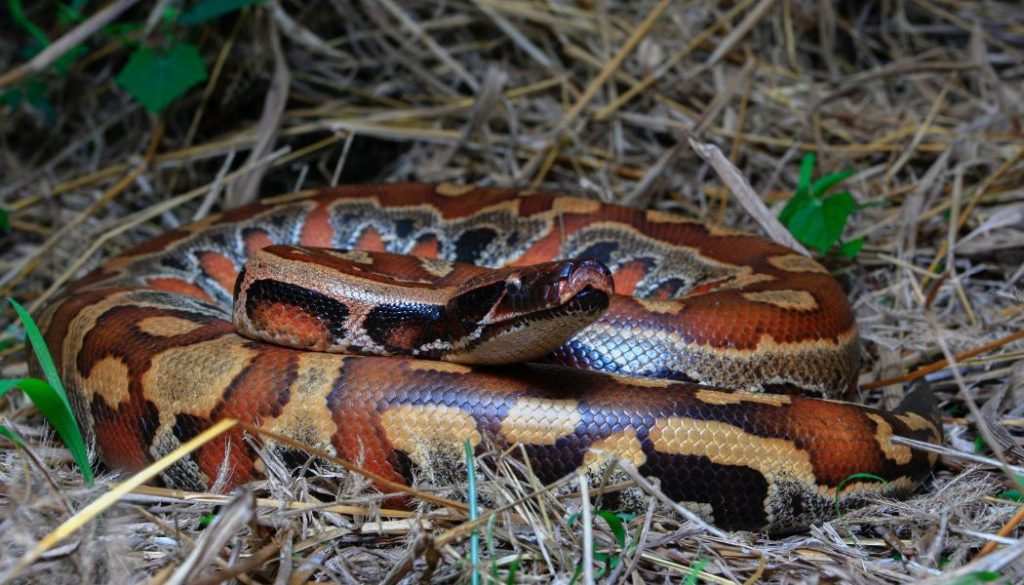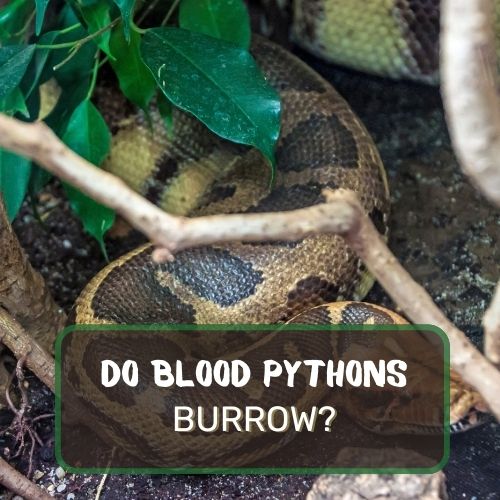Welcome to the fascinating world of blood pythons, where the art of shedding takes center stage.
Blood pythons typically shed every few months, but the frequency can vary. Juveniles may shed more often due to rapid growth, while factors like health, diet, and habitat conditions, especially humidity, also influence shedding frequency. Regular, complete sheds indicate a healthy python.
In this comprehensive guide, we delve into the intriguing process of how often blood pythons shed their skin.
From understanding the basic shedding cycle and its stages to addressing unique challenges in younger snakes, we’ve got it all covered.
We’ll explore factors like humidity, health, and environmental conditions that influence this natural phenomenon.
Whether you’re a seasoned python enthusiast or a curious newcomer, this article is your go-to resource for all things related to blood python shedding.
Join us as we unravel the secrets behind these magnificent creatures’ shedding habits!

Table of Contents
- 1 Overview of the Shedding Process in Blood Pythons
- 2 The Stages in the Shedding Cycle
- 3 Frequency of Shedding in Blood Pythons
- 4 Identifying Shedding Problems
- 5 Humidity and Its Role in Shedding
- 6 Dealing with Incomplete or Retained Sheds
- 7 Addressing Shedding Issues in Younger Snakes
- 8 Best Practices to Prevent Shedding Issues
- 9 Final Word
Overview of the Shedding Process in Blood Pythons
When you first bring a blood python into your home, you might be surprised to discover that these exotic creatures come with their unique set of behaviors and needs, one of which is shedding.
Shedding, or ecdysis, is a fascinating process where the python periodically replaces its old skin with a new layer. It’s like outgrowing an old jacket and finding a new one that fits just right!
For these slithering companions, shedding isn’t just about fashion—it’s a vital part of their health and well-being. As blood pythons grow, their skin doesn’t grow with them. Instead, they need to shed their old skin to accommodate their larger size. It’s a sign of good health and proper care.
But, the shedding process in blood pythons isn’t always straightforward or predictable. Various factors can influence how often they shed, such as their age, environmental conditions, diet, and overall health.
A young, rapidly growing blood python might shed more frequently than an adult. Similarly, a python in an environment that’s not quite right might struggle with the process.
Understanding the shedding process is crucial for any blood python owner. It’s not just about knowing when to expect your snake to start looking a bit shabby but also about ensuring they’re comfortable and healthy during this time. So, let’s dive into the stages of this incredible natural phenomenon!
The Stages in the Shedding Cycle
Pre-shedding: Dull Skin and Cloudy Eyes
The first sign that your blood python is entering the shedding cycle is a noticeable change in appearance. You might see their skin becoming dull and losing its usual sheen. Then, there’s the tell-tale sign of ‘blue’ or cloudy eyes.
This is due to fluid building up under the old skin, preparing to separate it from the new layer underneath. This stage can make them look a bit under the weather, but it’s a completely natural part of the cycle.
Opaque Phase: A Week of Waiting
After the initial changes, the python enters the opaque phase. Here, their eyes clear up, but the skin remains dull. This phase can be a bit confusing, especially for new owners. You might think the shedding is done because their eyes are no longer cloudy, but in reality, the main event is yet to come. This is the calm before the skin-shedding storm!
The Actual Shed: Out with the Old
Finally, we reach the peak of the shedding process. Your blood python will start rubbing its nose against various surfaces to loosen the old skin, starting the physical shedding. This phase is quite a sight to behold!
The old skin peels away, often in one piece, revealing the bright, new skin underneath. It’s a moment of transformation, a true shedding of the old, both literally and figuratively.
Frequency of Shedding in Blood Pythons
If you’re a blood python enthusiast, one question that might slither into your mind is: “How often do these magnificent creatures shed their skin?” Well, the answer isn’t as straightforward as one might hope, but let’s unravel this mystery.
First off, the frequency of shedding in blood pythons varies based on several factors, with age being a significant one. Juvenile pythons, who are in the midst of their rapid growth spurt, will shed more frequently than their adult counterparts.
It’s like how kids outgrow clothes faster than adults. These young snakes might shed every few weeks to accommodate their growing bodies.
As they mature, the frequency slows down. Adult blood pythons typically settle into a shedding rhythm of every few months. However, this isn’t set in stone. Factors like diet, health, and environment play a crucial role.
A python in tip-top health with a balanced diet in an ideal habitat might follow a consistent shedding schedule. On the flip side, if something’s amiss, like subpar nutrition or improper habitat conditions, your python’s shedding frequency might be thrown off balance.
It’s also worth noting that environmental factors like humidity and temperature are vital. Blood pythons thrive in a specific range of humidity and temperature, and any deviation can affect their shedding cycle. So, keep a keen eye on their living conditions to ensure a smooth shedding experience.
In essence, while there’s no one-size-fits-all answer to how often blood pythons shed, understanding the influencing factors can help you anticipate and prepare for your python’s next wardrobe change.
Identifying Shedding Problems
When it comes to blood pythons, shedding should be as smooth as their scales. However, sometimes things don’t go as planned. Here’s a rundown of common shedding problems to watch out for:
- Incomplete Sheds: This happens when parts of the old skin cling to the python, creating patchy areas. It’s like trying to take off a sticky sweater that just won’t budge.
- Retained Eye Caps: The old skin covering the eyes, or spectacles, should come off with the shed. If they don’t, your python might end up with retained eye caps, which can impede their vision.
- Dehydration: If your python isn’t getting enough water, its skin might not be supple enough for a successful shed. Imagine trying to peel an orange that’s gone a bit dry.
- Low Humidity: Blood pythons need a certain level of humidity for shedding. Too low, and their skin might not loosen up properly.
- Poor Nutrition: Just like humans, a python’s diet affects its skin. An imbalanced diet can lead to poor sheds.
- Stress: Stressful conditions can disrupt the shedding process. It’s like how stress affects human skin and hair.
- Health Issues: Sometimes, shedding problems are a symptom of underlying health issues. It’s a sign that your python might need a check-up.
If you notice any of these problems, it’s time to play detective. Check the habitat conditions, review their diet, and consider a vet visit. With a bit of care and attention, you can help your blood python slip out of its old skin and into the new with ease.
Humidity and Its Role in Shedding
Dive into the world of blood python shedding, and you’ll quickly find that humidity is more than just a weather report—it’s a crucial factor in your python’s skin health. Think of humidity as the secret ingredient in the recipe for a successful shed.
First, let’s set the scene: Blood pythons hail from humid environments where the air is like a gentle, moist embrace. This natural setting plays a pivotal role in their shedding process. In captivity, replicating this level of humidity is essential.
The sweet spot for these pythons typically lies around 50-70% humidity. It’s like creating a mini tropical paradise right in their enclosure.
But why is humidity such a big deal? Well, imagine trying to peel a sticker off a surface. If it’s dry, it tears and sticks, but if it’s moist, it comes off smoothly. The same principle applies to python shedding. Adequate humidity keeps the python’s skin flexible and eases its separation from the new layer underneath.
However, it’s a balancing act. Too much humidity can lead to other health issues, like respiratory infections or scale rot. So, while you’re playing rainmaker, keep an eye on the humidity levels. You might need to adjust your approach based on the season, as indoor air can be drier in winter or more humid in summer.
In summary, maintaining the right level of humidity in your blood python’s habitat is key to ensuring a smooth shedding process. It’s not just about keeping them comfortable; it’s about mimicking the natural conditions they thrive in, ensuring they stay healthy and happy.
Dealing with Incomplete or Retained Sheds
When your blood python’s shedding goes off-script with incomplete or retained sheds, it’s time to step in as the director of the operation. Here’s how you can help your scaly friend through these sticky situations:
- Increase Humidity: Start by bumping up the humidity in the enclosure. This can be as simple as misting more frequently or adding a larger water bowl. It’s like giving the environment a hydration boost.
- Bathing Sessions: Gently soak your python in lukewarm water. This helps soften the stubborn skin, making it easier to shed. Think of it as a relaxing spa day for your python.
- Create a Humid Hide: Place a hide box filled with moist sphagnum moss in the enclosure. This gives your python a humid microclimate to aid in shedding.
- Monitor Diet and Health: Sometimes, shedding issues are tied to diet or health problems. Ensure your python is eating well and check for any signs of illness.
- Handle with Care: If you need to manually remove retained skin, do it gently. Use a damp cloth to softly rub the area. It’s a delicate process, akin to removing a band-aid from sensitive skin.
- Seek Professional Help: When in doubt, consult a reptile veterinarian. They can provide expert care and advice, especially if the shedding issue persists.
Remember, while it’s tempting to jump in and peel away the retained skin, patience and gentle methods are key. Your intervention should be more of a helping hand than a forceful pull. By understanding and addressing these shedding issues, you’re not just caring for your python’s physical health but also ensuring its overall well-being.
Addressing Shedding Issues in Younger Snakes
When it comes to younger blood pythons, their shedding story is a bit different from the adults. These little ones are like the beginners in the shedding world, sometimes needing extra help. They’re growing fast, which means more frequent shedding, and with their smaller size, any retained shed can be a bigger issue.
The key here is vigilance. Keep a closer eye on their humidity levels and make sure they’re just right. Young pythons can dehydrate more quickly, so ensuring their environment is consistently humid is crucial. If a young python does experience an incomplete shed, address it promptly.
Soaking and creating a humid hide are great strategies. But remember, they’re delicate. Handling them should be gentle and supportive, much like helping a toddler with their shoes. By paying extra attention to these juvenile shedders, you’re setting the stage for their healthy growth and development.
Best Practices to Prevent Shedding Issues
Prevention is always better than cure, especially when it comes to blood python shedding. Here are some best practices to keep your python’s shedding as smooth as their scales:
- Maintain Proper Humidity: This is the golden rule. Keep the humidity levels in the ideal range to support regular, complete sheds.
- Regular Habitat Checks: Regularly check and adjust the temperature and humidity in the enclosure. A hygrometer can be your best friend here.
- Provide a Balanced Diet: Just like us, a healthy diet is essential for a healthy body. Ensure your python gets all the necessary nutrients for good skin health.
- Create a Stress-free Environment: Minimize stress by providing a calm, quiet habitat. Blood pythons are sensitive to disturbances, and stress can affect their shedding cycle.
- Regular Health Check-ups: Keep an eye on your python’s overall health and consult a vet if you notice any abnormalities.
By following these practices, you’re not just preventing shedding issues; you’re ensuring your python lives a happy, healthy life. It’s about creating an environment where they can thrive and shed without a hitch!
Final Word
As you’ve learned, shedding in blood pythons is a natural, essential process influenced by factors like age, health, and environment. Regular shedding every few months is typical, with juveniles shedding more frequently.
Remember, maintaining the right humidity and providing a balanced diet are crucial for healthy shedding. If issues arise, gentle care and prompt attention can resolve them. So, keep a watchful eye on your python’s shedding habits.
With your care and understanding, you’ll ensure they continue to thrive and showcase their stunning, new skin with each shed. Happy python keeping!




0 Comments